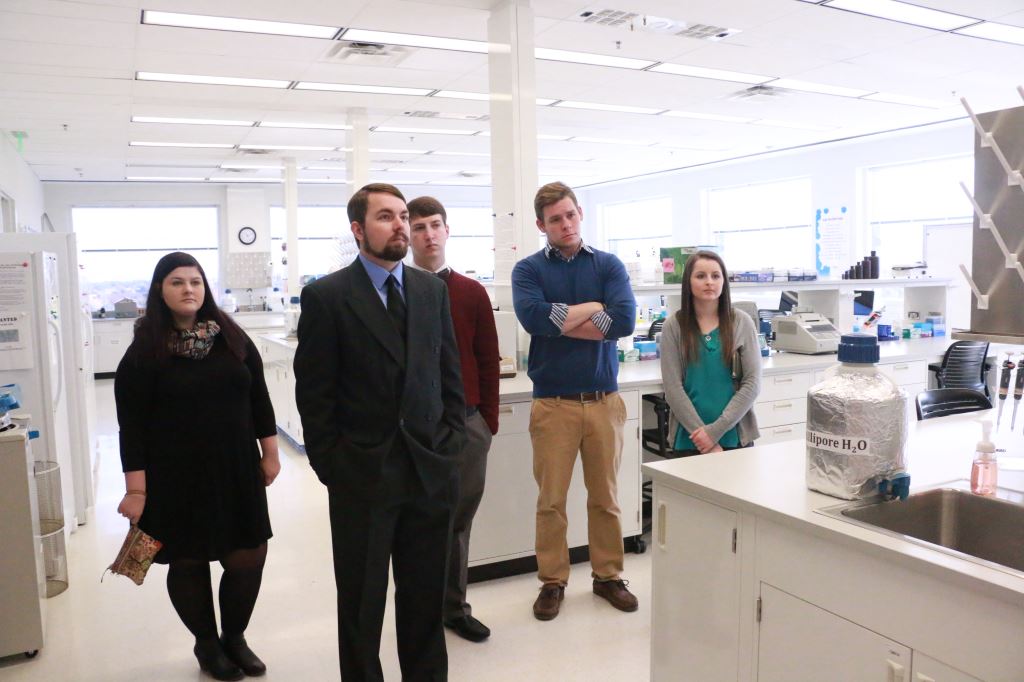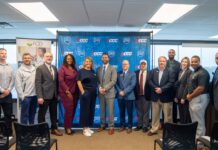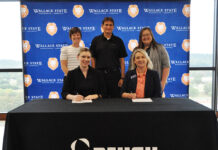Wallace State students, from left, Jordan Dover, Zach Brooks, David Hinds, Matt Rush and Lindsey Pope listen to a HudsonAlpha scientist during their visit to Huntsville.
HANCEVILLE – Thanks to Wallace State graduate Casey Smith teaming up with Dr. Jeremy Prokop at HudsonAlpha Institute for Biotechnology, a group of current biology students at Wallace State are getting a leg up in genetics research.
Every other Tuesday since late September, interested students within the biology department are meeting at Wallace State’s School of Nursing and Center for Science with Smith and Dr. Prokop, using computer programs to analyze changes in genetic variants to predict how those changes alter protein structures and affect cellular biology and disease.
Smith, 40, graduated from Wallace State in 2014, during her second stint at the college. After leaving Hanceville, Smith is currently taking courses at both Athens State and UAH in biology, where she joined Dr. Prokop to perform research using computers and bioinformatics. Dr. Prokop has started an initiative to bring research opportunities to students who normally do not have capacities to perform advanced research. Smith facilitated Wallace State to be the fourth institute to join HudsonAlpha in this Bioinformatics Research Opportunities club.
As Smith worked with Prokop – because of her love for Wallace State and biology – Smith thought it was ideal to see if any current Wallace State students were interested in learning about genetic research. Smith contacted the Wallace State biology department, including instructors Connie Briehn, Beth Williams and Wes Rakestraw, and a collaboration was formed.
“We had meetings like this over the last year at Athens State, and I thought it would be perfect to do the same at Wallace State. Dr. Prokop was very gracious and agreed to take time each week to come to Wallace State,” said Smith, a Fairview native. “It’s already a great thing and the pieces of the puzzle have fallen together perfectly. It’s very much an inspiration to me because I would have jumped at this chance as a student both times I was here.”
Added Wallace State’s Briehn: “We are very grateful Casey is trying to give back to our current students, and it shows their interest and dedication in the project to stay up here during the afternoon and evening hours. This is a wonderful opportunity. It not only gives interested students an opportunity to better understand molecular genetics and the growing field of Bioinformatics, but also provides them with a unique opportunity to perform undergraduate research, making them more attractive graduate school candidates.”
As many as 12 Wallace State students expressed interest in the initial meetings.
“We are modeling about 120 transcription factors in the body right now even though there are 2,000 overall in the human. Transcription factors are what causes your body to be your body. It tells what proteins to be produced in your body. For instance, transcription factors help a heart cell be a heart cell and a liver cell be a liver cell,” Smith said.
On a recent Tuesday afternoon, Wallace State students Zach Brooks, Jordan Dover, Matt Rush, David Hinds and Lindsey Pope met with Smith, Dr. Prokop and Athens State Assistant Professor of Biology Dr. Sara Cline. The first hour was spent with Prokop and Cline sharing tips and advice on items including effective letter of recommendations, strong resumes, medical school admittance policies and ways to make each individual stand out through their academic journeys.
Dr. Beth Johnson, Wallace State Dean of Academic Affairs, also participated in the discussion.
The students then joined Smith, Prokop and Cline in a computer lab. During this time the students get to see firsthand Dr. Prokop’s “Sequence-to-Structure-to-Function” (SSF) bioinformatics tools that combine protein modeling, molecular dynamic simulations, evolutionary analysis and predictions of protein interactions to characterize proteins and variations within proteins. These tools are currently funded by the National Institutes of Health to study genetic variants, with the hope to also train future scientist in genetic analysis. Opportunities for students at Wallace State highlight this potential.
Prokop is providing the bioinformatics software necessary during the meetings and a detailed protocol and training for the students to use his tools for research.
Prokop is impressed with the interest and desire the Wallace State students have demonstrated during the research meetings.
“The resources here are very good and this building is beautiful. It makes it worthwhile to see how excited the students get regarding this project, and that really makes it worth it. These students are going to gain great knowledge. They are definitely on the right track,” Prokop said. “These students are going to be walking into fields one day where sequencing every individual is normal. We have to develop a strong workforce and the right opportunities for research for students to understand what genetic variants are to be successful in these future jobs.”
Smith, who first attended Wallace State as a nursing student in the mid 1990s, envisions more Wallace State students becoming involved in the project as it evolves, opening up opportunities for these students that have not historically been available to students at a two year college.
“Biology is my second act in life, and I want to give back to Wallace State because it launched me. I see this project bringing in chemistry, physics and computer science students as it grows. The new cutting edge type of biology is biophysics, so we need physicists who understand the process of how proteins fold and things of that nature,” Smith said. “I literally have to pinch myself because I never in a million years would have thought these type of opportunities would have been presented to me. I’m very fortunate, and I want as many Wallace State students to take advantage of this opportunity as well.”
Additionally, the students engaging in the project recently visited the HudsonAlpha Institute for Biotechnology in Huntsville along with the Wallace State biology faculty.
If a student is interested in joining the group, contact Briehn at 256-352-8108.
For more information about Wallace State, visit www.wallacestate.edu.
About HudsonAlpha: HudsonAlpha Institute for Biotechnology is a nonprofit institute dedicated to innovating in the field of genomic technology and sciences across a spectrum of biological challenges. Opened in 2008, its mission is four-fold: sparking scientific discoveries that can impact human health and well-being; bringing genomic medicine into clinical care; fostering life sciences entrepreneurship and business growth; and encouraging the creation of a genomics-literate workforce and society. The HudsonAlpha biotechnology campus consists of 152 acres nestled within Cummings Research Park, the nation’s second largest research park. Designed to be a hothouse of biotech economic development, HudsonAlpha’s state-of-the-art facilities co-locate nonprofit scientific researchers with entrepreneurs and educators. The relationships formed on the HudsonAlpha campus encourage collaborations that produce advances in medicine and agriculture. Under the leadership of Dr. Richard M. Myers, a key collaborator on the Human Genome Project, HudsonAlpha has become a national and international leader in genetics and genomics research and biotech education, and includes more than 30 diverse biotech companies on campus. To learn more about HudsonAlpha, visit: http://hudsonalpha.org/.




























